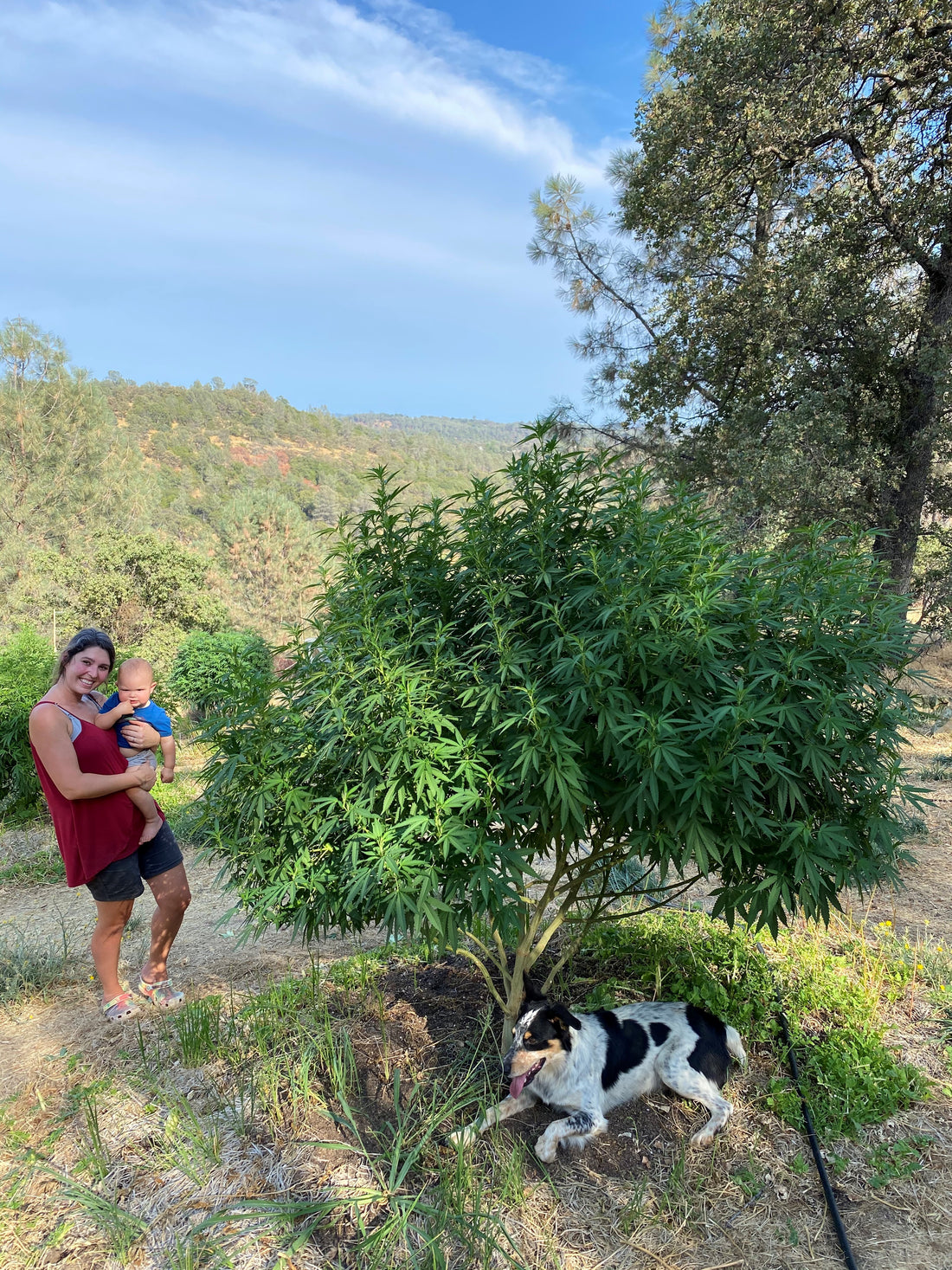
Cost Effective Cannabis: Cultivating Using Your Ecosystem
Share

Growing cannabis can become expensive when you buy everything from the hydro store. There are the pots, bags of potting mix, bottled nutrients, microbial products, pest treatments, and trellising. And this list doesn't even include your plant.
Luckily, you can get affordable seeds from the best breeders in the world right here!
Some folks will have you believe that all those products are necessary, and while they can achieve great results, they are unnecessary. We believe the best cannabis can be grown by utilizing your ecosystem for a fraction of the cost.
Plants have been growing on Earth for over 250 million years. They know what they are doing, and if you understand a little bit about the ecosystem processes required for plant growth, you can harness the resources provided naturally.
Plants need sunlight, soil, and nutrients to live. By planting outside, in the ground, you can freely harness most of your plant needs.
Sunlight And Photosynthesis
Plants consume sunlight in a process called photosynthesis. This process converts sunlight, carbon dioxide, and water into sugars. These sugars are fuel plants use for energy. When you grow outside, your plant has access to this energy from the sun.
Harnessing the sun's power is the first step in growing cannabis cost-effectively. When you rely on the sun instead of a grow light, you remove the need for electricity. Not only do grow lights require electricity but so do the air conditioner and dehumidifier that are often required when using grow lights.

Sunlight is free and is the center of all ecosystem processes, much like our continual rotation around the sun.
Cannabis grown outdoors utilizes this free energy source to fuel growth and development. But our plants need nutrients for growth and development.
Nutrients
Cannabis plants need 18 essential elements that are considered the macro and micronutrients. These nutrients are in the atmosphere, soil, and fertilizers.
You can get a complete soil analysis done by sending a sample of your garden soil to a university or private laboratory. These tests usually cost between $35-$100 and are great tools to determine your soil needs. Pay a little extra to get personalized consultation from an agronomist to review your test results and create customized recommendations as they do at Soilscape Solutions.
Farmers and commercial producers will test their soil annually. For home growers, testing your soil once is usually enough to determine how you should amend your soil.
You can conduct a simple at-home soil test for baseline guidance on your macronutrient, N-P-K, content. You can purchase these tests at nearly every gardening center, and they cost between $20-$80 depending on the number of tests you buy.

The primary macronutrients are Nitrogen, Phosphorus, and Potassium, which are used in large quantities by your plant. All elements have varying levels of mobility in your soil and within your plant, and because your plant uses these nutrients the most, it is a good idea to test your soil's macronutrients more frequently.
For example, Nitrogen is a mobile nutrient and will move out of your soil with water runoff and through your plant as needed. When your plant lacks Nitrogen, the older leaves will begin to yellow as the nutrient moves through the plant to new growth.
If you want to learn more about the function and characteristics of N-P-K, check out this article.
Most soil contains sufficient micronutrients. Depending on the amount of organic matter, pH, moisture, and oxygen in your soil, they can become difficult for your plant to access.
If you live in the United States, you can use this database to gather information about your soil based on previous testing. This data contains helpful information, such as if your soil is low in micronutrients like Manganese.
An easy way to ensure your plant has better access to the nutrients within your soil is to incorporate as much organic matter as possible.
Organic Matter
Adding organic matter to your soil will increase aeration, improve moisture levels and microbe content, and increase access to plant nutrients. Add organic matter by covering your garden with dead leaves, plants, straw, woodchips, manure, or compost.
Increasing your organic matter reduces watering time because water will be held within your soil longer since it acts like a sponge. This means your plant will have access to nutrients longer because plants consume nutrients suspended within the water.
Nutrients that are locked in your soil are made available to plants through microbial digestion.
Microbes decompose organic matter, the same ones sold in bottles at grow stores. Instead of paying for them, you can bring them to your plant by increasing the organic matter. These microbes produce enzymes that decompose the organic matter and make nutrients locked in your soil available to your plant.

To maximize cannabis yield and quality, you must provide your plants with more nutrients than what is typically available within our soil. We can work toward building our soil up through regenerative techniques, but this takes years of adding organic matter. In the meantime, you can feed your soil with fertilizers in the form of dry amendments.
You can apply dry amendments as a top dressing to your soil or water them by making homemade nutrient teas.
Brewing Nutrient Teas
A simple way to make nutrient teas is to look at your favourite organic or natural bottled nutrient ingredient list and replicate it with dry bulk materials. You can also make compost teas or create your teas with ferments you have gathered yourself.
Make a nutrient tea by combining water-soluble dry amendments into a water reservoir with a circulating air pump to agitate and dissolve the material. These materials can include fish hydrolysate, kelp extract, potassium silicate, micronized humate, and guanos.
Place insoluble ingredients into a mesh paint strainer, tie off, and suspend in your reservoir. It usually takes anywhere between 4 and 24 hours to extract the nutrients from the dry ingredients.

After aerating, you can apply the solution as a soil drench or, in some cases, a foliar feed. Foliar feeding is a much more efficient way of feeding your plant since plant leaves can absorb more nutrients than plant roots.
Creating nutrient teas like this is similar to aerated compost tea (ACT). Add an ACT to any feeding or nutrient recipe you come up with; add a cupful of compost to your mesh paint strainer.
By adding compost to your nutrient teas, you are inoculating your nutrient solution with microbes that will aid in the digestion of your nutrients and aid in your plant's immune system defence.
For more nutrient tea recipes and ideas click here.
Microbes
Microbes are tiny organisms that decompose organic matter and protect your plants from pests. They can be found everywhere and are integral parts of ecosystem processes. They cycle nutrients through our soil by decomposing organic matter and consuming nutrients. Microbes exchange nutrients for sugar from your plant's root tips.
Because they have a symbiotic relationship with your plants, they will work hard to protect them from pests. Good microbes like Bacillus bacteria will outcompete harmful microbes like botrytis (bud rot). Other microbes will cause blood poisoning within pests like caterpillars or fungus gnat larvae.
For plants and microbes to communicate, they produce volatile organic compounds (VOCs) that signal information. These VOCs are things like terpenes that can be smelled and are associated with the entourage effect when consumed with cannabinoids.

By having a healthy microbiome, your plant will produce more terpenes and fewer pests.
Different microbes are attracted to different plant species, so it is a good idea to incorporate other plant species near your cannabis for diversity.
Companion Planting
When you incorporate other plant species near your cannabis, you are practising companion planting. Having diverse plant species in your garden is great for many reasons.
Diversity in plants increases diverse microbial populations and your plant's defences against pests. This diversity can also boost your plant's terpene content. When insects attack a plant, it will communicate with other plants by producing more terpenes. The surrounding plants will then increase their terpene levels.
Many organic pest treatment products contain terpenes from plants like geraniums, thyme, oregano, and peppermint. These are great plants to consider using as companion plants so you can save money on pest prevention. You can also grow other mulch and biomass species to increase your soil's organic matter or to make ferments.

Companion planting can be used as a living mulch to cover the surface of your soil. When you cover your soil's surface, you reduce the soil temperature, which reduces the evaporation rate of water. This is good for your plant’s roots and saves you money on your water bill.
Living mulch can also be chopped and dropped on the soil’s surface to add organic matter consumed by microbes aiding in nutrient cycling. Or you can make ferments from plant materials rich in nutrients for a DIY fertilizer that is practically free. Companion planting can also attract beneficial insects.
Beneficial Insects
Have you ever seen lady beetles or lacewings for sale? These insects are predators of pest insects and are attracted to flowering plants—especially small white flowering plants like Sweet Alyssum or Buckwheat.
These insects not only defend your plants against pests, but some of them, like parasitic wasps, aid in pollinating native plants and cultivated crops. With the increased use of pesticides today, pollinators need all the help they can get.
You can create pollinator gardens as hedgerows or borders around and within your garden. This is an easy way to save money on pest treatment and add colour and beauty.

Insects are part of the ecosystem; avoiding them outside is impossible. Knowing your local environment and what kinds of insects live there their life cycle, and what they feed on will give you the tools necessary to work with nature instead of against it.
Holistic Horticulture
When you grow cannabis outside, you need to look at the whole picture; this is having a holistic view. Every part of the ecosystem interacts with another, whether it is your cannabis or companion plant, the beneficial insects that call your land home, or the microbes working tirelessly to unlock nutrients within your soil.
Working with your ecosystem is the most cost-effective and sustainable way to grow cannabis. It uses the least number of resources and produces very little waste. It is also a great way to become a better steward of our land. Taking care of our ecosystems will reward us in many ways.
Our outdoor gardens can provide us with free sunlight, minerals from the soil, and microbes to unlock them and defend our plants. We can grow other species that aid in that defence or produce free fertilizers.
By building up and regenerating our soils, we can secure a healthy future for generations so everyone can enjoy sun-grown cannabis.

